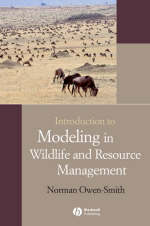
Introduction to Modeling in Wildlife and Resource Conservation
Wiley-Blackwell (Verlag)
978-1-4051-4439-1 (ISBN)
Develops thought-provoking applications which emphasize the value of modeling as a learning tool
Examines basic descriptive equations, matrix representations, consumer-resources interactions, applications in simulation, scenarios, harvesting, population viability, metapopulation dynamics, disease outbreaks, vegetation stage and state dynamics, habitat suitability assessment, and model selection statistics
Includes a wide range of examples relating to birds, fish, plants and large African mammals
Norman Owen-Smith is Research Professor in African Ecology in the School of Animal, Plant, and Environmental Sciences at the University of the Witwatersrand in South Africa. He teaches ecology at undergraduate and postgraduate levels, and is well-known internationally for his research into all aspects of wildlife ecology and bioresource conservation.
Preface. 1 Introduction: why learn modeling?.
1.1 Introduction.
1.2 Structure of the book.
1.3 Supporting computer software.
Recommended supporting reading.
Supporting file on the CD.
2 A starting problem: conservation of the dodo.
2.1 Introduction.
2.2 Conservation of the dodo.
3 Descriptive models: choosing an equation.
3.1 Introduction.
3.2 Dynamic equations.
3.3 Geometric and exponential growth.
3.4 Adding a population ceiling.
3.5 Basic density-dependent models.
3.6 Curvilinear density dependence.
3.7 Delayed density dependence.
3.8 Depensation or Allee effect.
3.9 Incorporating environmental variability.
3.10 Overview.
Recommended supporting reading.
Programs on the accompanying CD.
Exercises.
4 Structured population models: age, size, or stage.
4.1 Introduction.
4.2 Age-structured models.
4.3 Stage-structured models.
4.4 Projection versus prediction.
4.5 Overview.
Recommended supporting reading.
Programs on the accompanying CD.
Exercises.
5 Consumer–resource models: population interactions.
5.1 Introduction.
5.2 Coupling population equations.
5.3 Simple interactive model.
5.4 Incorporating competitive interference.
5.5 Ratio-dependent intake response and time frames.
5.6 Accommodating environmental variability.
5.7 Overview.
Recommended supporting reading.
Programs on the accompanying CD.
Exercises.
6 Simulation models: assessing understanding.
6.1 Introduction.
6.2 Adding density dependence to an age-structured model.
6.3 Aspecific example: the kudu model.
6.4 Simplification for management.
6.5 Generalizing the model for other species.
6.6 Overview.
Recommended supporting reading.
Programs on the accompanying CD.
Exercises.
7 Harvesting models: adaptive management.
7.1 Introduction.
7.2 Principles of “maximum sustained yield”.
7.3 Surplus production model accommodating environmental variability.
7.4 Stock-recruitment model.
7.5 Policies for setting the harvest quota.
7.6 Adaptive management responses.
7.7 Stock-recruitment models for fish populations.
7.8 Overview.
Recommended supporting reading.
Programs on the accompanying CD.
Exercises.
8 Population viability models: risk analysis.
8.1 Introduction.
8.2 Demographic stochasticity.
8.3 Environmental variability and catastrophes.
8.4 Genetic stochasticity.
8.5 Population viability models.
8.6 Overview.
Recommended supporting reading.
Programs on the accompanying CD.
Exercises.
9 Metapopulation models: spreading the risk.
9.1 Introduction.
9.2 Basic patch incidence model.
9.3 Correlated migration and extinction.
9.4 Variable patch size and spacing.
9.5 Source and sink populations.
9.6 Mainland–island habitats.
9.7 Examples of vertebrate metapopulations.
9.8 Overview.
Recommended supporting reading.
Exercises.
10 Modeling infectious diseases: outbreak dynamics.
10.1 Introduction.
10.2 Basic infection model.
10.3 Cyclic outbreak dynamics: measles.
10.4 Slowly spreading sexually transmitted disease: HIV–AIDS.
10.5 Controlling the spread of wildlife diseases.
10.6 Overview.
Recommended supporting reading.
Exercises.
11 Scenario models: exploring options.
11.1 Introduction.
11.2 Background situation.
11.3 Theoretical concepts.
11.4 Modeling the white rhino–grassland system.
11.5 Exploring management options.
11.6 Overview.
Recommended supporting reading.
Program on the accompanying CD.
Exercises.
12 Vegetation models: biomass to gap dynamics.
12.1 Introduction.
12.2 Seasonal biomass dynamics of vegetation supporting herbivores.
12.3 Size-structured dynamics of a tree population.
12.4 Gap dynamics model.
12.5 Overview.
Recommended supporting reading.
Programs on the accompanying CD.
Exercises.
13 State transition models: habitat patch dynamics.
13.1 Introduction.
13.2 Vegetation successional dynamics.
13.3 Managing savanna vegetation for livestock.
13.4 Spatially explicit grid model.
13.5 Overview.
Recommended supporting reading.
Programs on the accompanying CD.
Exercises.
14 Habitat suitability models: adaptive behavior.
14.1 Introduction.
14.2 Shifting habitat use by overwintering geese.
14.3 Habitat suitability for a browsing antelope from vegetation composition.
14.4 General principles.
14.5 Overview.
Recommended supporting reading.
Programs on the accompanying CD.
Exercises.
15 Reconciling models with data: statistical diagnosis.
15.1 Introduction.
15.2 Model selection statistics.
15.3 Diagnosing the causes of antelope population declines.
15.4 Overview.
Recommended supporting reading.
Programs on the accompanying CD.
Exercise.
Appendices.
References.
Index
| Erscheint lt. Verlag | 31.5.2007 |
|---|---|
| Verlagsort | Hoboken |
| Sprache | englisch |
| Maße | 156 x 235 mm |
| Gewicht | 526 g |
| Themenwelt | Informatik ► Grafik / Design ► Digitale Bildverarbeitung |
| Naturwissenschaften ► Biologie ► Ökologie / Naturschutz | |
| ISBN-10 | 1-4051-4439-4 / 1405144394 |
| ISBN-13 | 978-1-4051-4439-1 / 9781405144391 |
| Zustand | Neuware |
| Haben Sie eine Frage zum Produkt? |
aus dem Bereich


